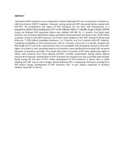| dc.description.abstract | Nevirapine (NVP) resistance occurs frequently in infants following NVP use in prevention of mother-to-child transmission (PMTCT) regimens. However, among previously NVP-unexposed infants treated with NVP-ART, the development and impact of NVP resistance has not been well characterized. In a prospective clinical trial providing early ART to HIV-infected infants <5 months of age in Kenya (OPH03 study), we followed NVP-unexposed infants who initiated NVP-ART for 12 months. Viral loads were assessed, and resistance determined using a population-based genotypic resistance assay. Of 99 infants screened, 33 had no prior NVP exposure, 22 of whom were initiated on NVP-ART. Among 19 infants with follow-up, 7 (37%) infants developed resistance: 1 at 3 months, and 6 at 6 months after ART initiation. Cumulative probability of NVP resistance was 5.9% at 3 months, and 43.5% at 6 months. Baseline HIV RNA levels (p=0.7) and other characteristics were not associated with developing resistance. Post-ART, higher virus levels at visits preceding detection of resistance were significantly associated with increased detection of resistance (p=0.004). Virus levels after 6 and 12 months of ART were significantly higher in infants with resistance than those without (p=0.007, p=0.030, respectively). Among infants without previous NVP exposure, development of NVP resistance was frequent and was associated with virologic failure during the first year of ART. Earlier development of NVP-resistance in infants than in adults initiating NVP-ART may be due to longer viremia following ART or inadequate NVP levels resulting from NVP lead-in dosing. Development of NVP resistance may, in part, explain superiority of protease inhibitor-based ART in infants. | en_US |

